Applications of Metal–Organic Frameworks and Their Derivatives in Lithium–Sulfur Battery Separators: Advances and Prospectives Focusing on Cathode-Side Polysulfide Regulation
Abstract
1. Introduction
1.1. Mechanisms of LSBs
- (1)
- Stage I: Solid–Liquid Transition (S8 → Li2S8)
- (2)
- Stage II: Liquid-Phase Redox Reaction (Li2S8 → Li2S6 → Li2S4)
- (3)
- Stage III: Liquid–Solid Precipitation (Li2S4 → Li2S2)
- (4)
- Stage IV: Solid–Solid Phase Transformation (Li2S2 → Li2S)
1.2. Challenges for LSBs
1.3. Separator Modification for High-Performance LSBs
1.4. Metal–Organic Frameworks (MOFs) for LSB Separator Modification
2. The MOFs and Their Derivatives for LSB Separator Fabrication
2.1. Pristine MOF-Based Separators
2.1.1. Tailoring Pore Microenvironments in Pristine MOFs
2.1.2. Engineering Metal Sites of MOFs
2.1.3. Enhancing Electrical Conductivity of MOFs
2.2. MOF-Derivative-Based Separators
- Structural versatility and inherited porosity: MOF derivatives often preserve the inherent porous architectures of their parent frameworks, resulting in abundant ion-diffusion channels and extensive active interfaces for LiPS interaction. This structural advantage enables effective LiPS confinement and Li+ transport simultaneously.
- Improved chemical and electrochemical stability: Compared to pristine MOFs, which may suffer from instability in electrolyte environments, MOF derivatives (especially carbonized or oxidized forms) exhibit a superior chemical robustness, ensuring prolonged durability during long-term cycling.
- High electronic conductivity from carbon-interconnected frameworks: MOF derivatives synthesized via thermal treatment frequently form conductive carbon skeletons. These frameworks not only suppress shuttle effects, but also act as secondary sulfur hosts within the separator, enabling sulfur species to participate reversibly in redox reactions. This contributes to higher sulfur utilization and an improved long-term cycling stability.
- Strong polarity and tunable surface chemistry: Most MOF derivatives exhibit a high polarity and surface activity. These features enhance the chemical anchoring of LiPSs and facilitate redox kinetics. Depending on their specific compositions, certain derivatives may provide stronger LiPS adsorption while others function more effectively as catalytic centers.
- Compatibility with scalable processing methods: MOF derivatives, available in powder, nanosheet, or hybrid composite forms, can be readily integrated into separators using industrially scalable techniques such as slurry casting, vacuum filtration, and spray coating. This enables practical implementation in commercial LSB configurations.
2.2.1. Metal Sulfides
2.2.2. Metal Phosphides
2.2.3. Metal Selenides
3. Conclusions and Future Perspectives
Author Contributions
Funding
Institutional Review Board Statement
Informed Consent Statement
Data Availability Statement
Conflicts of Interest
References
- Raza, H.; Bai, S.; Cheng, J.; Majumder, S.; Zhu, H.; Liu, Q.; Zheng, G.; Li, X.; Chen, G. Li-S Batteries: Challenges, Achievements and Opportunities. Electrochem. Energy Rev. 2023, 6, 29. [Google Scholar] [CrossRef]
- Dunn, B.; Kamath, H.; Tarascon, J.M. Electrical energy storage for the grid: A battery of choices. Science 2011, 334, 928–935. [Google Scholar] [CrossRef]
- Chen, S.; Qiu, L.; Cheng, H.M. Carbon-Based Fibers for Advanced Electrochemical Energy Storage Devices. Chem. Rev. 2020, 120, 2811–2878. [Google Scholar] [CrossRef] [PubMed]
- Li, Z.; Wang, J.; Yuan, H.; Yu, Y.; Tan, Y. Recent Progress and Challenge in Metal–Organic Frameworks for Lithium–Sulfur Battery Separators. Adv. Funct. Mater. 2024, 34, 2405890. [Google Scholar] [CrossRef]
- Lu, J.; Luo, S.; Qi, Z.; Chen, T.; Li, X.; Yuan, T.; Pang, Y.; Zheng, S. Recent advances in transition metal chalcogenide derivatives from metal-organic frameworks for lithium-sulfur batteries. Cell Rep. Phys. Sci. 2024, 5, 102028. [Google Scholar] [CrossRef]
- Min, B.C.; Park, J.B.; Choi, C.; Kim, D.-W. Dynamic construction of a composite solid electrolyte interphase for dendrite-free lithium metal batteries via lithium-antimony self-alloying. Adv. Compos. Hybrid Mater. 2024, 8, 4. [Google Scholar] [CrossRef]
- Gao, G.; Yang, X.; Bi, J.; Guan, W.; Du, Z.; Ai, W. Advanced engineering strategies for Li2S cathodes in lithium–sulfur batteries. J. Mater. Chem. A 2023, 11, 26318–26339. [Google Scholar] [CrossRef]
- Zhang, H.; Cheng, J.; Liu, H.; Li, D.; Zeng, Z.; Li, Y.; Ji, F.; Guo, Y.; Wei, Y.; Zhang, S.; et al. Prelithiation: A Critical Strategy Towards Practical Application of High-Energy-Density Batteries. Adv. Energy Mater. 2023, 13, 2300466. [Google Scholar] [CrossRef]
- Chen, Y.; Wang, T.; Tian, H.; Su, D.; Zhang, Q.; Wang, G. Advances in Lithium-Sulfur Batteries: From Academic Research to Commercial Viability. Adv. Mater. 2021, 33, e2003666. [Google Scholar] [CrossRef]
- Qi, F.; Sun, Z.; Fan, X.; Wang, Z.; Shi, Y.; Hu, G.; Li, F. Tunable Interaction between Metal-Organic Frameworks and Electroactive Components in Lithium–Sulfur Batteries: Status and Perspectives. Adv. Energy Mater. 2021, 11, 2100387. [Google Scholar] [CrossRef]
- Seo, S.-D.; Choi, C.; Kim, D.-W. Fabrication of sulfur-impregnated porous carbon nanostructured electrodes via dual-mode activation for lithium–sulfur batteries. Mater. Lett. 2016, 172, 116–119. [Google Scholar] [CrossRef]
- Lee, D.; Choi, C.; Park, J.B.; Jung, S.W.; Kim, D.-W. Ingenious separator architecture: Revealing the versatile 3D heterostructured MXene-hydrogen titanate electrocatalysts for advanced lithium-sulfur battery. Energy Storage Mater. 2024, 70, 103529. [Google Scholar] [CrossRef]
- Bruce, P.G.; Freunberger, S.A.; Hardwick, L.J.; Tarascon, J.M. Li-O2 and Li-S batteries with high energy storage. Nat. Mater. 2011, 11, 19–29. [Google Scholar] [CrossRef]
- Qiu, S.; Zhang, J.; Liang, X.; Li, Y.; Cui, J.; Chen, M. Tunable MOFs derivatives for stable and fast sulfur electrodes in Li-S batteries. Chem. Eng. J. 2022, 450, 138287. [Google Scholar] [CrossRef]
- Li, T.; Bai, X.; Gulzar, U.; Bai, Y.J.; Capiglia, C.; Deng, W.; Zhou, X.; Liu, Z.; Feng, Z.; Proietti Zaccaria, R. A Comprehensive Understanding of Lithium–Sulfur Battery Technology. Adv. Funct. Mater. 2019, 29, 1901730. [Google Scholar] [CrossRef]
- Pan, Z.; Brett, D.J.L.; He, G.; Parkin, I.P. Progress and Perspectives of Organosulfur for Lithium–Sulfur Batteries. Adv. Energy Mater. 2022, 12, 2103483. [Google Scholar] [CrossRef]
- Song, Z.; Jiang, W.; Li, B.; Qu, Y.; Mao, R.; Jian, X.; Hu, F. Advanced Polymers in Cathodes and Electrolytes for Lithium-Sulfur Batteries: Progress and Prospects. Small 2024, 20, e2308550. [Google Scholar] [CrossRef]
- Kolosnitsyn, V.S.; Kuzmina, E.V.; Karaseva, E.V. On the reasons for low sulphur utilization in the lithium–sulphur batteries. J. Power Sources 2015, 274, 203–210. [Google Scholar] [CrossRef]
- Jin, Z.; Lin, T.; Jia, H.; Liu, B.; Zhang, Q.; Li, L.; Zhang, L.; Su, Z.M.; Wang, C. Expediting the Conversion of Li(2)S(2) to Li(2)S Enables High-Performance Li-S Batteries. ACS Nano 2021, 15, 7318–7327. [Google Scholar] [CrossRef]
- Hu, A.; Zhou, M.; Lei, T.; Hu, Y.; Du, X.; Gong, C.; Shu, C.; Long, J.; Zhu, J.; Chen, W.; et al. Optimizing Redox Reactions in Aprotic Lithium–Sulfur Batteries. Adv. Energy Mater. 2020, 10, 2002180. [Google Scholar] [CrossRef]
- Moon, S.; Jung, Y.H.; Jung, W.K.; Jung, D.S.; Choi, J.W.; Kim, D.K. Encapsulated monoclinic sulfur for stable cycling of li-s rechargeable batteries. Adv. Mater. 2013, 25, 6547–6553. [Google Scholar] [CrossRef] [PubMed]
- Lee, J.; Kim, S.; Park, J.B.; Park, D.; Lee, S.; Choi, C.; Lee, H.; Jang, G.; Park, Y.S.; Yun, J.; et al. Electrochemically Active MoO3/TiN Sulfur Host Inducing Dynamically Reinforced Built-in Electric Field for Advanced Lithium-Sulfur Batteries. Small 2024, 20, e2406018. [Google Scholar] [CrossRef] [PubMed]
- Miao, K.; Chen, F.; Ma, C.; Zhou, J. Progresses and outlooks of all-solid-state lithium-sulfur batteries for practical development. Chem. Eng. J. 2025, 512, 162173. [Google Scholar] [CrossRef]
- Huang, Y.; Lin, L.; Zhang, C.; Liu, L.; Li, Y.; Qiao, Z.; Lin, J.; Wei, Q.; Wang, L.; Xie, Q.; et al. Recent Advances and Strategies toward Polysulfides Shuttle Inhibition for High-Performance Li-S Batteries. Adv. Sci. 2022, 9, e2106004. [Google Scholar] [CrossRef]
- Seo, S.-D.; Choi, C.; Kim, B.-K.; Kim, D.-W. Fabrication of highly porous carbon as sulfur hosts using waste green tea bag powder for lithium–sulfur batteries. Ceram. Int. 2017, 43, 2836–2841. [Google Scholar] [CrossRef]
- Zhu, Q.; Sun, W.; Zhou, H.; Mao, D. A Review of Lithium–Sulfur Batteries Based on Metal–Organic Frameworks: Progress and Prospects. Batteries 2025, 11, 89. [Google Scholar] [CrossRef]
- Kim, J.S.; Hwang, T.H.; Kim, B.G.; Min, J.; Choi, J.W. A Lithium-Sulfur Battery with a High Areal Energy Density. Adv. Funct. Mater. 2014, 24, 5359–5367. [Google Scholar] [CrossRef]
- Choi, C.; Lee, D.-Y.; Park, J.B.; Kim, D.-W. Separators Modified Using MoO2@Carbon Nanotube Nanocomposites as Dual-Mode Li-Polysulfide Anchoring Materials for High-Performance Anti-Self-Discharge Lithium–Sulfur Batteries. ACS Sustain. Chem. Eng. 2020, 8, 15134–15148. [Google Scholar] [CrossRef]
- Jang, K.; Song, H.J.; Park, J.B.; Jung, S.W.; Kim, D.-W. Magnesium fluoride-engineered UiO-66 artificial protection layers for dendrite-free lithium metal batteries. Energy Environ. Sci. 2024, 17, 4622–4633. [Google Scholar] [CrossRef]
- Shi, P.; Cheng, X.B.; Li, T.; Zhang, R.; Liu, H.; Yan, C.; Zhang, X.Q.; Huang, J.Q.; Zhang, Q. Electrochemical Diagram of an Ultrathin Lithium Metal Anode in Pouch Cells. Adv. Mater. 2019, 31, e1902785. [Google Scholar] [CrossRef]
- Park, J.B.; Choi, C.; Yu, S.; Chung, K.Y.; Kim, D.W. Porous Lithiophilic Li–Si Alloy-Type Interfacial Framework via Self-Discharge Mechanism for Stable Lithium Metal Anode with Superior Rate. Adv. Energy Mater. 2021, 11, 2101544. [Google Scholar] [CrossRef]
- Xia, S.; Xu, X.; Wu, W.; Chen, Y.; Liu, L.; Wang, G.; Fu, L.; Zhang, Q.; Wang, T.; He, J.; et al. Advancements in functionalized high-performance separators for lithium-sulfur batteries. Mater. Sci. Eng. R Rep. 2025, 163, 100924. [Google Scholar] [CrossRef]
- Liu, M.; Hu, L.J.; Guan, Z.K.; Chen, T.L.; Zhang, X.Y.; Sun, S.; Shi, R.; Jing, P.; Wang, P.F. Tailoring Cathode-Electrolyte Interface for High-Power and Stable Lithium-Sulfur Batteries. Nano Micro Lett. 2024, 17, 85. [Google Scholar] [CrossRef] [PubMed]
- Heo, J.; Gu, H.; Lee, C.; Sung, J.; Kim, D.H.; Han, J.; Oh, Y.S.; Ahn, S.; Jeon, I.; Park, J.W. Recent Advances in Achieving High Energy/Power Density of Lithium–Sulfur Batteries for Current and Near-Future Applications. Battery Energy 2025, e20240051. [Google Scholar] [CrossRef]
- Fang, R.; Zhao, S.; Sun, Z.; Wang, D.W.; Cheng, H.M.; Li, F. More Reliable Lithium-Sulfur Batteries: Status, Solutions and Prospects. Adv. Mater. 2017, 29, 1606823. [Google Scholar] [CrossRef] [PubMed]
- Pan, H.; Cheng, Z.; Fransaer, J.; Luo, J.; Wübbenhorst, M. Cobalt-embedded 3D conductive honeycomb architecture to enable high-sulphur-loading Li-S batteries under lean electrolyte conditions. Nano Res. 2022, 15, 8091–8100. [Google Scholar] [CrossRef]
- Jin, M.; Sun, G.; Wang, Y.; Yuan, J.; Zhao, H.; Wang, G.; Zhou, J.; Xie, E.; Pan, X. Boosting Charge Transport and Catalytic Performance in MoS2 by Zn2+ Intercalation Engineering for Lithium-Sulfur Batteries. ACS Nano 2024, 18, 2017–2029. [Google Scholar] [CrossRef]
- Huang, Y.; Zhang, L.; Ji, J.; Cai, C.; Fu, Y. Temperature-dependent viscoelastic liquid MOFs based cellulose gel electrolyte for advanced lithium-sulfur batteries over an extensive temperature range. Energy Storage Mater. 2024, 64, 103065. [Google Scholar] [CrossRef]
- Kim, A.; Oh, S.H.; Adhikari, A.; Sathe, B.R.; Kumar, S.; Patel, R. Recent advances in modified commercial separators for lithium–sulfur batteries. J. Mater. Chem. A 2023, 11, 7833–7866. [Google Scholar] [CrossRef]
- Chen, M.; Shao, M.; Jin, J.; Cui, L.; Tu, H.; Fu, X. Configurational and structural design of separators toward shuttling-free and dendrite-free lithium-sulfur batteries: A review. Energy Storage Mater. 2022, 47, 629–648. [Google Scholar] [CrossRef]
- Su, Y.S.; Manthiram, A. Lithium-sulphur batteries with a microporous carbon paper as a bifunctional interlayer. Nat. Commun. 2012, 3, 1166. [Google Scholar] [CrossRef]
- Jeong, Y.C.; Kim, J.H.; Nam, S.; Park, C.R.; Yang, S.J. Rational Design of Nanostructured Functional Interlayer/Separator for Advanced Li–S Batteries. Adv. Funct. Mater. 2018, 28, 1707411. [Google Scholar] [CrossRef]
- He, J.; Chen, Y.; Manthiram, A. Vertical Co9S8 hollow nanowall arrays grown on a Celgard separator as a multifunctional polysulfide barrier for high-performance Li–S batteries. Energy Environ. Sci. 2018, 11, 2560–2568. [Google Scholar] [CrossRef]
- Choi, C.; Kim, D.-W. Silica-templated hierarchically porous carbon modified separators for lithium–sulfur batteries with superior cycling stabilities. J. Power Sources 2020, 448, 227462. [Google Scholar] [CrossRef]
- Chen, P.; Wang, T.; He, D.; Shi, T.; Chen, M.; Fang, K.; Lin, H.; Wang, J.; Wang, C.; Pang, H. Delocalized Isoelectronic Heterostructured FeCoOx Sy Catalysts with Tunable Electron Density for Accelerated Sulfur Redox Kinetics in Li-S batteries. Angew. Chem. Int. Ed. 2023, 62, e202311693. [Google Scholar] [CrossRef] [PubMed]
- Phung, J.; Zhang, X.; Deng, W.; Li, G. An overview of MOF-based separators for lithium-sulfur batteries. Sustain. Mater. Technol. 2022, 31, e00374. [Google Scholar] [CrossRef]
- Li, M.; Wang, C.; Miao, L.; Xiang, J.; Wang, T.; Yuan, K.; Chen, J.; Huang, Y. A separator-based lithium polysulfide recirculator for high-loading and high-performance Li–S batteries. J. Mater. Chem. A 2018, 6, 5862–5869. [Google Scholar] [CrossRef]
- Fan, Y.; Yang, Z.; Hua, W.; Liu, D.; Tao, T.; Rahman, M.M.; Lei, W.; Huang, S.; Chen, Y. Functionalized Boron Nitride Nanosheets/Graphene Interlayer for Fast and Long-Life Lithium–Sulfur Batteries. Adv. Energy Mater. 2017, 7, 1602380. [Google Scholar] [CrossRef]
- Yang, Y.; Wang, W.; Meng, G.; Zhang, J. Function-directed design of battery separators based on microporous polyolefin membranes. J. Mater. Chem. A 2022, 10, 14137–14170. [Google Scholar] [CrossRef]
- He, Y.; Qiao, Y.; Chang, Z.; Zhou, H. The potential of electrolyte filled MOF membranes as ionic sieves in rechargeable batteries. Energy Environ. Sci. 2019, 12, 2327–2344. [Google Scholar] [CrossRef]
- Zhou, C.; He, Q.; Li, Z.; Meng, J.; Hong, X.; Li, Y.; Zhao, Y.; Xu, X.; Mai, L. A robust electrospun separator modified with in situ grown metal-organic frameworks for lithium-sulfur batteries. Chem. Eng. J. 2020, 395, 124979. [Google Scholar] [CrossRef]
- Freund, R.; Zaremba, O.; Arnauts, G.; Ameloot, R.; Skorupskii, G.; Dinca, M.; Bavykina, A.; Gascon, J.; Ejsmont, A.; Goscianska, J.; et al. The Current Status of MOF and COF Applications. Angew. Chem. Int. Ed. 2021, 60, 23975–24001. [Google Scholar] [CrossRef] [PubMed]
- Xu, G.; Zhu, C.; Gao, G. Recent Progress of Advanced Conductive Metal-Organic Frameworks: Precise Synthesis, Electrochemical Energy Storage Applications, and Future Challenges. Small 2022, 18, e2203140. [Google Scholar] [CrossRef] [PubMed]
- Yaghi, O.M.; Li, H. Hydrothermal Synthesis of a Metal-Organic Framework Containing Large Rectangular Channels. J. Am. Chem. Soc. 2002, 117, 10401–10402. [Google Scholar] [CrossRef]
- Cheng, Z.; Fang, Y.; Dai, W.; Zhang, J.; Xiang, S.; Zhang, Z. Structural engineering of metal–organic layers toward stable Li–CO2 batteries. J. Mater. Chem. A 2023, 11, 1180–1187. [Google Scholar] [CrossRef]
- Kang, X.; He, T.; Zou, R.; Niu, S.; Ma, Y.; Zhu, F.; Ran, F. Size Effect for Inhibiting Polysulfides Shuttle in Lithium-Sulfur Batteries. Small 2024, 20, e2306503. [Google Scholar] [CrossRef]
- Li, J.; Xie, F.; Pang, W.; Liang, Q.; Yang, X.; Zhang, L. Regulate transportation of ions and polysulfides in all-solid-state Li-S batteries using ordered-MOF composite solid electrolyte. Sci. Adv. 2024, 10, eadl3925. [Google Scholar] [CrossRef]
- Cheng, Z.; Lian, J.; Zhang, J.; Xiang, S.; Chen, B.; Zhang, Z. Pristine MOF Materials for Separator Application in Lithium-Sulfur Battery. Adv. Sci. 2024, 11, e2404834. [Google Scholar] [CrossRef]
- Fan, X.; Zhang, Y.; Peng, R.; Liang, Z.; Zhou, X.; Luo, X.; Chen, R.; Li, P.; Yu, D. Metal Organic Frameworks as Polysulfide Reaction Modulators for Lithium Sulfur Batteries: Advances and Perspectives. Chemphyschem 2024, 25, e202400239. [Google Scholar] [CrossRef]
- Yuan, N.; Sun, W.; Yang, J.; Gong, X.; Liu, R. Multifunctional MOF-Based Separator Materials for Advanced Lithium–Sulfur Batteries. Adv. Mater. Interfaces 2021, 8, 2001941. [Google Scholar] [CrossRef]
- Zhao, T.; Xiao, P.; Nie, S.; Luo, M.; Zou, M.; Chen, Y. Recent progress of metal-organic frameworks based high performance batteries separators: A review. Coord. Chem. Rev. 2024, 502, 215592. [Google Scholar] [CrossRef]
- Furukawa, H.; Cordova, K.E.; O’Keeffe, M.; Yaghi, O.M. The chemistry and applications of metal-organic frameworks. Science 2013, 341, 1230444. [Google Scholar] [CrossRef]
- Furukawa, H.; Ko, N.; Go, Y.B.; Aratani, N.; Choi, S.B.; Choi, E.; Yazaydin, A.O.; Snurr, R.Q.; O’Keeffe, M.; Kim, J.; et al. Ultrahigh porosity in metal-organic frameworks. Science 2010, 329, 424–428. [Google Scholar] [CrossRef]
- Jiang, H.; Liu, X.C.; Wu, Y.; Shu, Y.; Gong, X.; Ke, F.S.; Deng, H. Metal-Organic Frameworks for High Charge-Discharge Rates in Lithium-Sulfur Batteries. Angew. Chem. Int. Ed. 2018, 57, 3916–3921. [Google Scholar] [CrossRef] [PubMed]
- Suriyakumar, S.; Stephan, A.M.; Angulakshmi, N.; Hassan, M.H.; Alkordi, M.H. Metal–organic framework@SiO2 as permselective separator for lithium–sulfur batteries. J. Mater. Chem. A 2018, 6, 14623–14632. [Google Scholar] [CrossRef]
- Wang, Z.; Huang, W.; Hua, J.; Wang, Y.; Yi, H.; Zhao, W.; Zhao, Q.; Jia, H.; Fei, B.; Pan, F. An Anionic-MOF-Based Bifunctional Separator for Regulating Lithium Deposition and Suppressing Polysulfides Shuttle in Li–S Batteries. Small Methods 2020, 4, 2000082. [Google Scholar] [CrossRef]
- Park, J.H.; Choi, C.; Park, J.B.; Yu, S.; Kim, D.W. Fortifying Zinc Metal Anodes against Uncontrollable Side-Reactions and Dendrite Growth for Practical Aqueous Zinc Ion Batteries: A Novel Composition of Anti-Corrosive and Zn2+ Regulating Artificial Protective Layer. Adv. Energy Mater. 2023, 14, 2302493. [Google Scholar] [CrossRef]
- Baumann, A.E.; Burns, D.A.; Liu, B.; Thoi, V.S. Metal-organic framework functionalization and design strategies for advanced electrochemical energy storage devices. Commun. Chem. 2019, 2, 86. [Google Scholar] [CrossRef]
- Chang, Z.; Qiao, Y.; Wang, J.; Deng, H.; He, P.; Zhou, H. Fabricating better metal-organic frameworks separators for Li–S batteries: Pore sizes effects inspired channel modification strategy. Energy Storage Mater. 2020, 25, 164–171. [Google Scholar] [CrossRef]
- Chen, Y.; Zhang, L.; Pan, H.; Zhang, J.; Xiang, S.; Cheng, Z.; Zhang, Z. Pore-space-partitioned MOF separator promotes high-sulfur-loading Li–S batteries with intensified rate capability and cycling life. J. Mater. Chem. A 2021, 9, 26929–26938. [Google Scholar] [CrossRef]
- Zhou, M.; Li, Y.; Lei, T.; Chen, W.; Rao, G.; Xue, L.; Hu, A.; Fan, Y.; Huang, J.; Hu, Y.; et al. Ion-Inserted Metal-Organic Frameworks Accelerate the Mass Transfer Kinetics in Lithium-Sulfur Batteries. Small 2021, 17, e2104367. [Google Scholar] [CrossRef] [PubMed]
- Hong, X.J.; Song, C.L.; Yang, Y.; Tan, H.C.; Li, G.H.; Cai, Y.P.; Wang, H. Cerium Based Metal-Organic Frameworks as an Efficient Separator Coating Catalyzing the Conversion of Polysulfides for High Performance Lithium-Sulfur Batteries. ACS Nano 2019, 13, 1923–1931. [Google Scholar] [CrossRef]
- Ren, L.; Sun, K.; Wang, Y.; Kumar, A.; Liu, J.; Lu, X.; Zhao, Y.; Zhu, Q.; Liu, W.; Xu, H.; et al. Tandem Catalysis inside Double-Shelled Nanocages with Separated and Tunable Atomic Catalyst Sites for High Performance Lithium-Sulfur Batteries. Adv. Mater. 2024, 36, e2310547. [Google Scholar] [CrossRef] [PubMed]
- Lu, H.; Zeng, Q.; Xu, L.; Xiao, Y.; Xie, L.; Yang, J.; Rong, J.; Weng, J.; Zheng, C.; Zhang, Q.; et al. Multimodal Engineering of Catalytic Interfaces Confers Multi-Site Metal-Organic Framework for Internal Preconcentration and Accelerating Redox Kinetics in Lithium-Sulfur Batteries. Angew. Chem. Int. Ed. 2024, 63, e202318859. [Google Scholar] [CrossRef] [PubMed]
- Jin, Y.; Deng, N.; Li, Y.; Wang, H.; Zhang, M.; Kang, W.; Cheng, B. Advanced preparation and application of bimetallic materials in lithium-sulfur batteries: A review. J. Energy Chem. 2024, 88, 469–512. [Google Scholar] [CrossRef]
- Liu, L.; Chen, Z.; Wang, J.; Zhang, D.; Zhu, Y.; Ling, S.; Huang, K.W.; Belmabkhout, Y.; Adil, K.; Zhang, Y.; et al. Imaging defects and their evolution in a metal-organic framework at sub-unit-cell resolution. Nat. Chem. 2019, 11, 622–628. [Google Scholar] [CrossRef] [PubMed]
- Jin, H.G.; Wang, M.; Wen, J.X.; Han, S.H.; Hong, X.J.; Cai, Y.P.; Li, G.; Fan, J.; Chao, Z.S. Oxygen Vacancy-Rich Mixed-Valence Cerium MOF: An Efficient Separator Coating to High-Performance Lithium-Sulfur Batteries. ACS Appl. Mater. Interfaces 2021, 13, 3899–3910. [Google Scholar] [CrossRef]
- Li, Y.; Lin, S.; Wang, D.; Gao, T.; Song, J.; Zhou, P.; Xu, Z.; Yang, Z.; Xiao, N.; Guo, S. Single Atom Array Mimic on Ultrathin MOF Nanosheets Boosts the Safety and Life of Lithium-Sulfur Batteries. Adv. Mater. 2020, 32, e1906722. [Google Scholar] [CrossRef]
- Zhou, C.; Chen, M.; Dong, C.; Wang, H.; Shen, C.; Wu, X.; An, Q.; Chang, G.; Xu, X.; Mai, L. The continuous efficient conversion and directional deposition of lithium (poly)sulfides enabled by bimetallic site regulation. Nano Energy 2022, 98, 107332. [Google Scholar] [CrossRef]
- Leng, X.; Zeng, J.; Yang, M.; Li, C.; Vattikuti, S.V.P.; Chen, J.; Li, S.; Shim, J.; Guo, T.; Ko, T.J. Bimetallic Ni–Co MOF@PAN modified electrospun separator enhances high-performance lithium-sulfur batteries. J. Energy Chem. 2023, 82, 484–496. [Google Scholar] [CrossRef]
- Zhang, X.; Li, G.; Zhang, Y.; Luo, D.; Yu, A.; Wang, X.; Chen, Z. Amorphizing metal-organic framework towards multifunctional polysulfide barrier for high-performance lithium-sulfur batteries. Nano Energy 2021, 86, 106094. [Google Scholar] [CrossRef]
- Li, S.; Lin, J.; Ding, Y.; Xu, P.; Guo, X.; Xiong, W.; Wu, D.Y.; Dong, Q.; Chen, J.; Zhang, L. Defects Engineering of Lightweight Metal-Organic Frameworks-Based Electrocatalytic Membrane for High-Loading Lithium-Sulfur Batteries. ACS Nano 2021, 15, 13803–13813. [Google Scholar] [CrossRef] [PubMed]
- Wang, X.; Zhang, X.; Zhao, Y.; Luo, D.; Shui, L.; Li, Y.; Ma, G.; Zhu, Y.; Zhang, Y.; Zhou, G.; et al. Accelerated Multi-step Sulfur Redox Reactions in Lithium-Sulfur Batteries Enabled by Dual Defects in Metal-Organic Framework-based Catalysts. Angew. Chem. Int. Ed. 2023, 62, e202306901. [Google Scholar] [CrossRef] [PubMed]
- Sun, L.; Campbell, M.G.; Dinca, M. Electrically Conductive Porous Metal-Organic Frameworks. Angew. Chem. Int. Ed. 2016, 55, 3566–3579. [Google Scholar] [CrossRef] [PubMed]
- Day, R.W.; Bediako, D.K.; Rezaee, M.; Parent, L.R.; Skorupskii, G.; Arguilla, M.Q.; Hendon, C.H.; Stassen, I.; Gianneschi, N.C.; Kim, P.; et al. Single Crystals of Electrically Conductive Two-Dimensional Metal-Organic Frameworks: Structural and Electrical Transport Properties. ACS Cent. Sci. 2019, 5, 1959–1964. [Google Scholar] [CrossRef] [PubMed]
- Cong, C.; Ma, H. Advances of Electroactive Metal-Organic Frameworks. Small 2023, 19, e2207547. [Google Scholar] [CrossRef] [PubMed]
- Zang, Y.; Pei, F.; Huang, J.; Fu, Z.; Xu, G.; Fang, X. Large-Area Preparation of Crack-Free Crystalline Microporous Conductive Membrane to Upgrade High Energy Lithium–Sulfur Batteries. Adv. Energy Mater. 2018, 8, 1802052. [Google Scholar] [CrossRef]
- Guo, T.; Ding, Y.; Xu, C.; Bai, W.; Pan, S.; Liu, M.; Bi, M.; Sun, J.; Ouyang, X.; Wang, X.; et al. High Crystallinity 2D pi-d Conjugated Conductive Metal-Organic Framework for Boosting Polysulfide Conversion in Lithium-Sulfur Batteries. Adv. Sci. 2023, 10, e2302518. [Google Scholar] [CrossRef]
- Seo, S.D.; Park, D.; Park, S.; Kim, D.W. “Brain-Coral-Like” Mesoporous Hollow CoS2@N-Doped Graphitic Carbon Nanoshells as Efficient Sulfur Reservoirs for Lithium–Sulfur Batteries. Adv. Funct. Mater. 2019, 29, 1903712. [Google Scholar] [CrossRef]
- Cai, D.; Liu, B.; Zhu, D.; Chen, D.; Lu, M.; Cao, J.; Wang, Y.; Huang, W.; Shao, Y.; Tu, H.; et al. Ultrafine Co3Se4 Nanoparticles in Nitrogen-Doped 3D Carbon Matrix for High-Stable and Long-Cycle-Life Lithium Sulfur Batteries. Adv. Energy Mater. 2020, 10, 1904273. [Google Scholar] [CrossRef]
- Sun, Z.; Sun, B.; Xue, J.; He, J.; Zhao, R.; Chen, Z.; Sun, Z.; Liu, H.K.; Dou, S.X. ZIF-67/ZIF-8 and its Derivatives for Lithium Sulfur Batteries. Adv. Funct. Mater. 2024, 35, 2414671. [Google Scholar] [CrossRef]
- Seo, S.-D.; Choi, C.; Park, D.; Lee, D.-Y.; Park, S.; Kim, D.-W. Metal-organic-framework-derived 3D crumpled carbon nanosheets with self-assembled CoxSy nanocatalysts as an interlayer for lithium-sulfur batteries. Chem. Eng. J. 2020, 400, 125959. [Google Scholar] [CrossRef]
- Jin, L.; Huang, B.; Qian, X.; Chen, J.; Cheng, J.; Hao, Q.; Zhang, K. Hollow bimetallic sulfide composite coated separator for hindering the shuttle of polysulfides in Li-S batteries. J. Alloys Compd. 2022, 926, 166515. [Google Scholar] [CrossRef]
- Jin, L.; Huang, B.; Qian, X. ZIF-67 Derived Hollow Co9S8 as an Efficient Polysulfides Prohibitor for High Performance Lithium-Sulfur Batteries. ChemElectroChem 2022, 9, e202101337. [Google Scholar] [CrossRef]
- Xu, J.; Zhang, W.; Fan, H.; Cheng, F.; Su, D.; Wang, G. Promoting lithium polysulfide/sulfide redox kinetics by the catalyzing of zinc sulfide for high performance lithium-sulfur battery. Nano Energy 2018, 51, 73–82. [Google Scholar] [CrossRef]
- Jin, L.; Chen, J.; Fu, Z.; Qian, X.; Cheng, J.; Hao, Q.; Zhang, K. ZIF-8/ZIF-67 derived ZnS@Co-N-C hollow core-shell composite and its application in lithium-sulfur battery. Sustain. Mater. Technol. 2023, 35, e00571. [Google Scholar] [CrossRef]
- Li, F.; Qian, X.; Jin, L. MOF-Derived MnS/N–C@CNT Composites as Separator Coating Materials for Long-Cycling Li–S Batteries. ACS Sustain. Chem. Eng. 2021, 9, 15469–15477. [Google Scholar] [CrossRef]
- Wang, X.; Zhang, G.; Wang, Q.; Li, Y.; Guo, S. Regulating the phase and catalytic activity of cobalt phosphide based on the morphological engineering of ZIF-67 to enhance the redox kinetics of polysulfides for high-performance lithium-sulfur batteries. J. Alloys Compd. 2023, 967, 171730. [Google Scholar] [CrossRef]
- Zhu, H.; Dong, S.; Xiong, J.; Wan, P.; Jin, X.; Lu, S.; Zhang, Y.; Fan, H. MOF derived cobalt-nickel bimetallic phosphide (CoNiP) modified separator to enhance the polysulfide adsorption-catalysis for superior lithium-sulfur batteries. J. Colloid Interface Sci. 2023, 641, 942–949. [Google Scholar] [CrossRef]
- Zhang, X.; Gu, H.; Shen, C.; Wei, B.; Wang, J.G. Catalytic Boosting Bidirectional Polysulfide Redox using Co0.85Se/C Hollow Structure for High-Performance Lithium-Sulfur Batteries. ChemElectroChem 2022, 9, e202101557. [Google Scholar] [CrossRef]
- Sun, Q.; Zhang, Y.; Zhou, H.; Ma, C.; Zhang, Y.; Wang, J.; Qiao, W.; Ling, L. Boosting polysulfide confinement and redox kinetics via ZnSe/NC@rGO as separator modifier for high-performance lithium-sulfur batteries. Electrochim. Acta 2023, 445, 142026. [Google Scholar] [CrossRef]
- Wang, B.; Sun, D.; Ren, Y.; Zhou, X.; Ma, Y.; Tang, S.; Meng, X. MOFs derived ZnSe/N-doped carbon nanosheets as multifunctional interlayers for ultralong-Life lithium-sulfur batteries. J. Mater. Sci. Technol. 2022, 125, 97–104. [Google Scholar] [CrossRef]
- Shi, Y.; Xu, G.; Liang, G.; Lan, D.; Zhang, S.; Wang, Y.; Li, D.; Wu, G. PEG-VN modified PP separator for high-stability and high-efficiency lithium-sulfur batteries. Acta Phys.-Chim. Sin. 2025, 41, 100082. [Google Scholar] [CrossRef]
- Lin, C.; Feng, P.; Wang, D.; Chen, X.; Fang, Y.; Gao, Y.; Zheng, Y.; Yan, Y.; Liu, M. Safe, Facile, and Straightforward Fabrication of Poly(N-vinyl imidazole)/Polyacrylonitrile Nanofiber Modified Separator as Efficient Polysulfide Barrier Toward Durable Lithium–Sulfur Batteries. Adv. Funct. Mater. 2024, 35, 2411872. [Google Scholar] [CrossRef]
- Wang, R.; Ma, C.; Li, C.; Zhang, W.; Zhang, C.; Wang, J.; Xiao, L.; Lv, B.; Guo, S.; Yao, S. Keggin-type potassium phosphotungstate modified functionalization of carbon nanotubes hybrid materials for capture and boost conversion of polysulfides in lithium sulfur batteries. J. Energy Storage 2025, 109, 115168. [Google Scholar] [CrossRef]
- Hu, C.; Zhang, Y.; Li, J.; Cui, H.; Liu, K.; Liu, Y.; Yang, Y.; Wang, M. Ion selective rapid transport enabled by functionalized CeO2/LiX zeolite modified separator in high performance lithium sulfur batteries. Chem. Eng. J. 2025, 503, 158218. [Google Scholar] [CrossRef]
- Li, Z.; Cong, Y.; Zhao, J.; Su, H.; Shang, Y.; Liu, H. Polyaniline-Coated Cobalt–Iron Oxide Composites Modified Separator for High Performance Lithium–Sulfur Batteries. ACS Appl. Electron. Mater. 2024, 6, 3780–3789. [Google Scholar] [CrossRef]
- Wang, T.; Shi, Z.; Wang, F.; Cui, S.; Zhang, Z.; Liu, W.; Jin, Y. Nanorod In2O3@C Modified Separator with Improved Adsorption and Catalytic Conversion of Soluble Polysulfides for High-Performance Lithium-Sulfur Batteries. ACS Appl. Mater. Interfaces 2024, 16, 18937–18948. [Google Scholar] [CrossRef]
- Li, Y.; Gao, T.; Ni, D.; Zhou, Y.; Yousaf, M.; Guo, Z.; Zhou, J.; Zhou, P.; Wang, Q.; Guo, S. Two Birds with One Stone: Interfacial Engineering of Multifunctional Janus Separator for Lithium-Sulfur Batteries. Adv. Mater. 2022, 34, e2107638. [Google Scholar] [CrossRef]
- Qi, X.; Huang, L.; Luo, Y.; Chen, Q.; Chen, Y. Ni3Sn2/nitrogen-doped graphene composite with chemisorption and electrocatalysis as advanced separator modifying material for lithium sulfur batteries. J. Colloid Interface Sci. 2022, 628, 896–910. [Google Scholar] [CrossRef]
- Li, L.; Liu, H.; Jin, B.; Sheng, Q.; Li, Q.; Cui, M.; Li, Y.; Lang, X.; Jiang, Q. Functional Separator Modified with Reduced Graphene Oxide and Fe3S4 for High-Performance Lithium–Sulfur Batteries. ACS Appl. Nano Mater. 2023, 6, 1161–1170. [Google Scholar] [CrossRef]
- Yan, M.; Zhao, C.; Li, X. Preparation of Bacterial Cellulose/Ketjen Black-TiO2 Composite Separator and Its Application in Lithium-Sulfur Batteries. Polymers 2022, 14, 5559. [Google Scholar] [CrossRef] [PubMed]


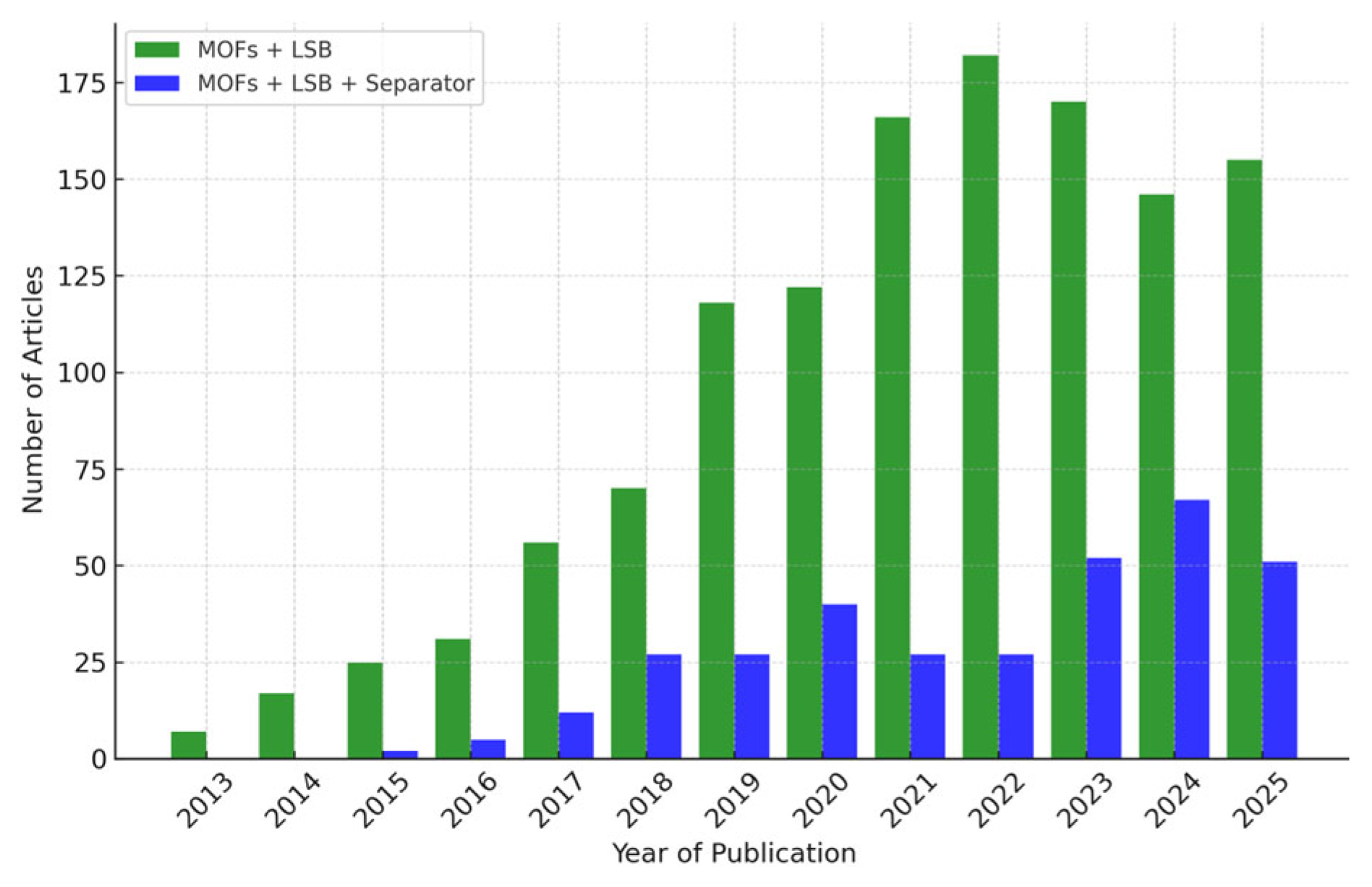
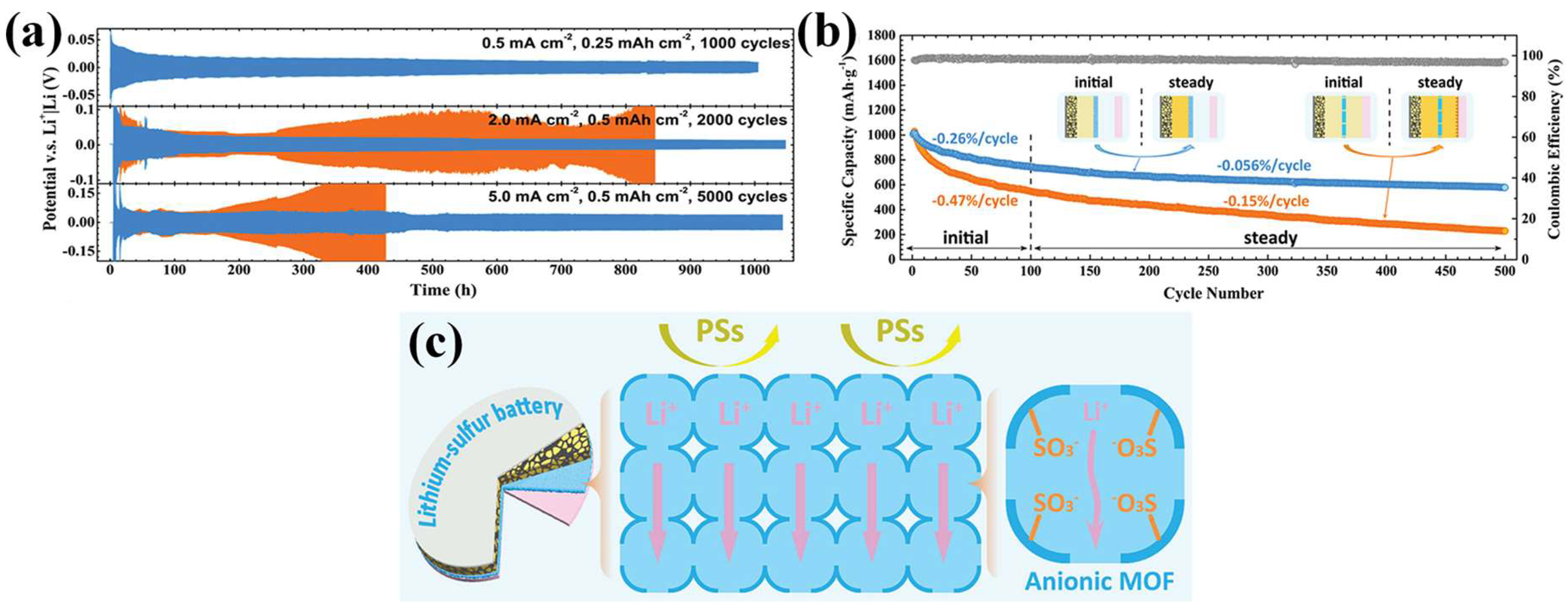
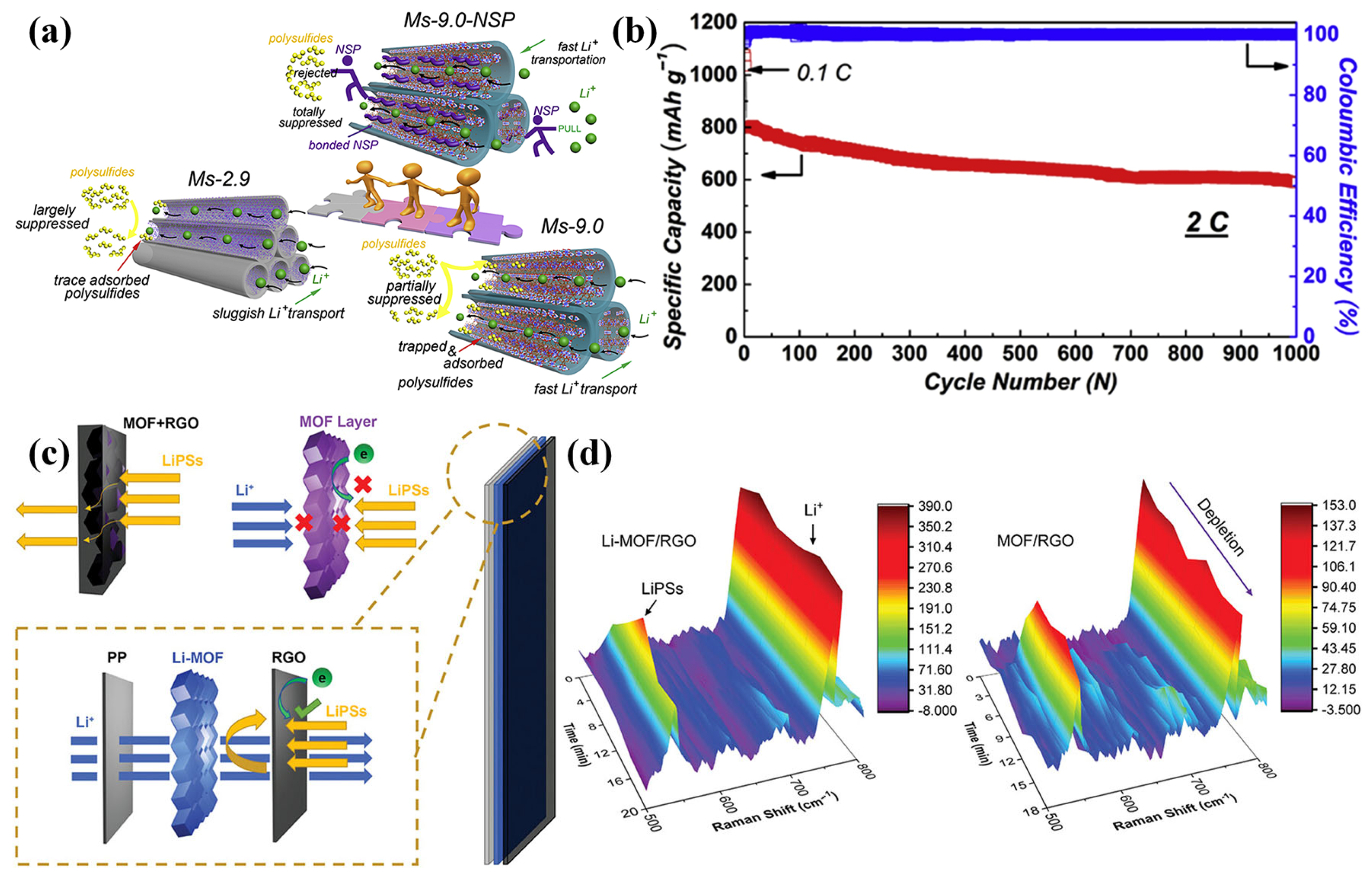

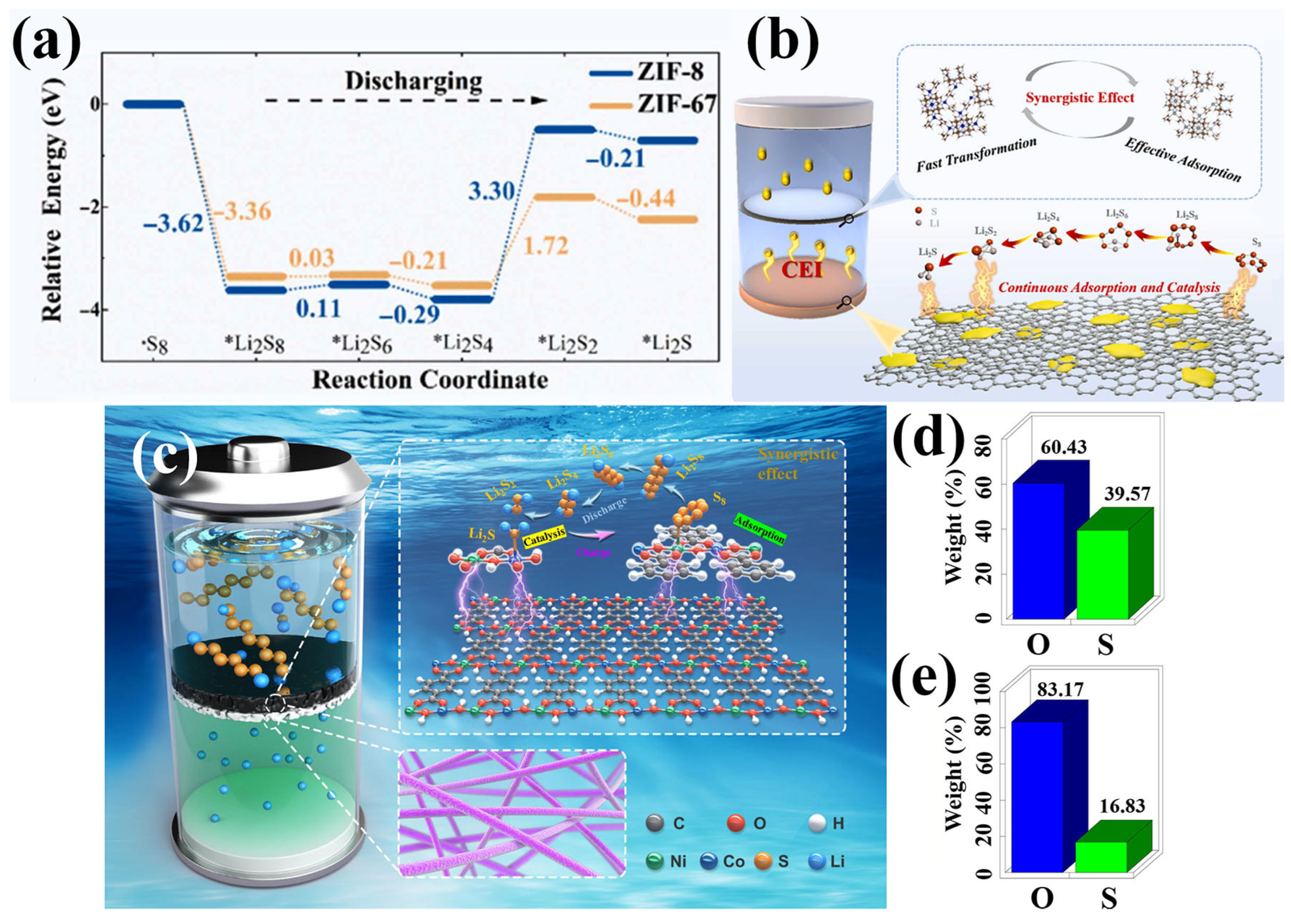
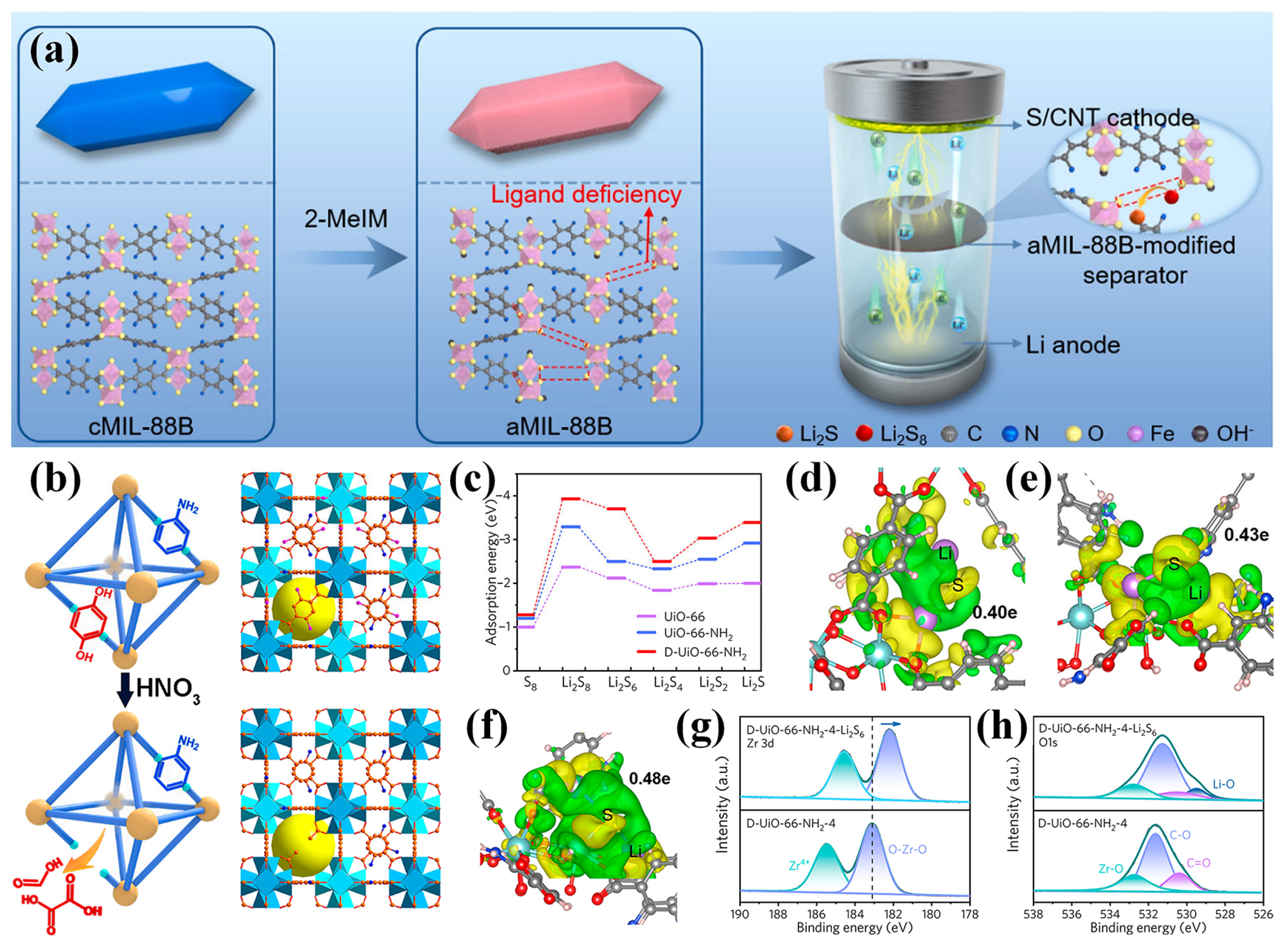
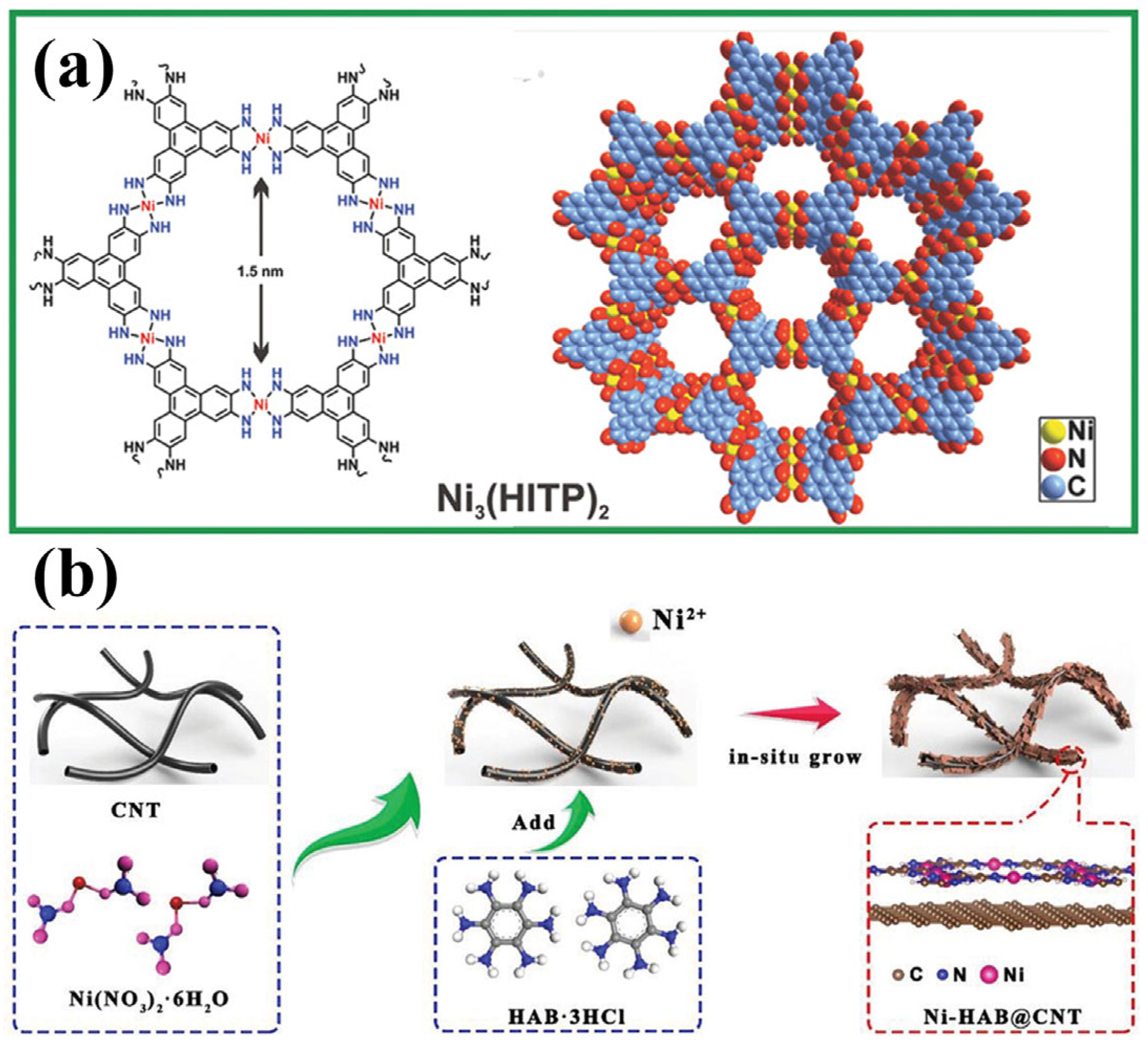
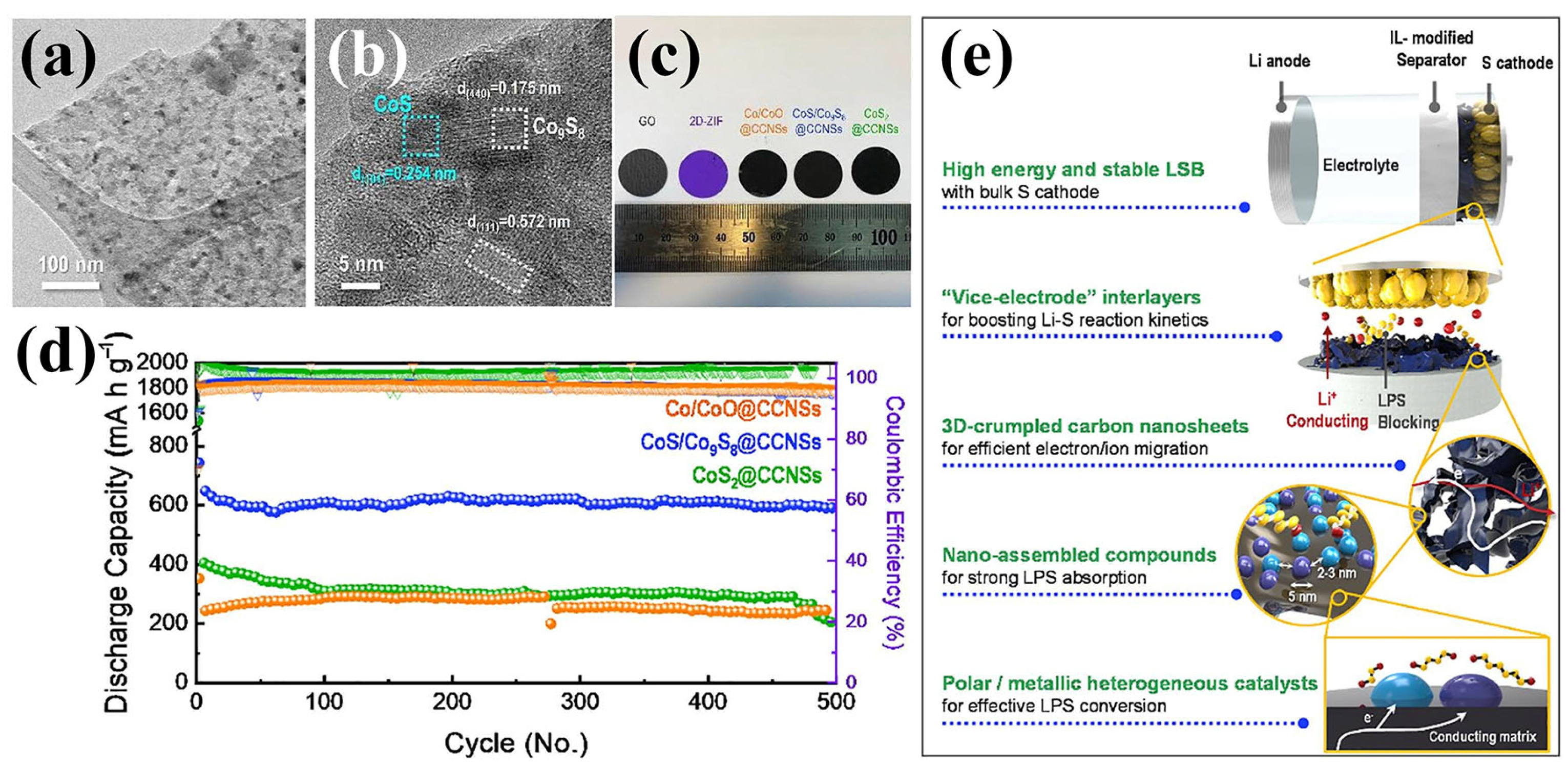


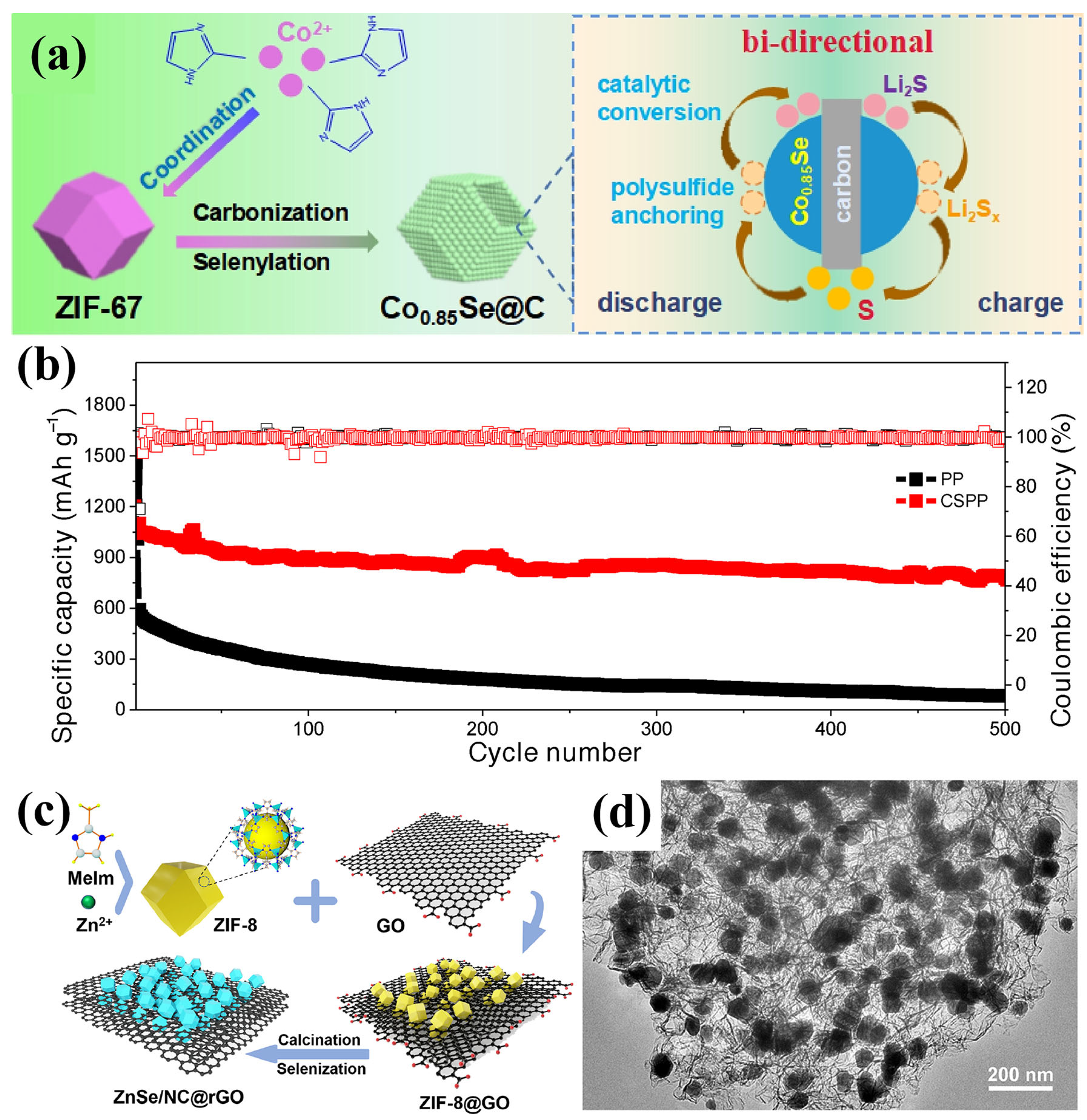

| Material | Sulfur Loading (mg cm−2) | Initial Capacity (mAh g−1) | Cycling Performance (mAh g−1) | Rate Performance (mAh g−1) | Ref | |
|---|---|---|---|---|---|---|
| Pristine MOFs | Li/PVDF | 2.0 | 1069 (0.1 C) | 580 (500th/0.5 C) | 552 (5 C) | [66] |
| Ms-9.0-NSP | 5.12 | 1076(0.1 C) | 1000 (1000th/0.5 C) | 589 (2 C) | [69] | |
| Li-MOF/RGO | 5.1 | 1374 (0.2 C) | 942 (600th/1 C) | 742 (2 C) | [71] | |
| CSUST-1/CNT | 8 | 1468 (0.1 C) | 708 (600th/1 C) | 538 (2 C) | [77] | |
| ZIF-B@PP | 5.3 | 1304 (0.5 C) | 630 (1000th/2 C) | 788 (3 C) | [79] | |
| Ni–Co MOF@PAN | 1.2–2.0 | 1560 (0.1 C) | 794 (500th/1 C) | 782 (2 C) | [80] | |
| aMIL-88B | 4.3 | 1058 (0.1 C) | 740 (500th/1 C) | 610 (5 C) | [81] | |
| /G | 1.5 | 1304 (0.1 C) | 696 (600th/3 C) | - | [82] | |
| Ni3(HITP)2/PP + S/CB | 3.5 | 851 (1 C) | 716 (500th/1 C) | 589 (5 C) | [87] | |
| Ni3(HITP)2/PP + S/CNT | 8.0 | 1055 (0.5 C) | 905 (200th/0.5 C) | - | ||
| Ni-HAB@CNT | 6.5 | 1310 (0.2 C) | 1070 (200th/0.2 C) | 799 (3 C) | [88] | |
| MOF derivatives | @CCNS | 2.0–2.3 | 1392 (0.2 C) | 600 (500th/1 C) | - | [92] |
| ZnS@Co-N-C | 3 | 1180 (0.2 C) | 570 (500th/1 C) | - | [96] | |
| MnS/N−C@CNT/PE | 3.3 | 1181 (0.1 C) | 500.8 (500th/0.5 C) | > 500 (2 C) | [97] | |
| F-cobalt phosphide | 4.0 | 1253.6 (0.2 C) | 520 (800th/0.2 C) | 858.7 (2 C) | [98] | |
| NiCoP@NC/PP | 2.3 | 1364.3 (0.2 C) | 772.1 (300th/0.5 C) | - | [99] | |
| Se/C(CSPP) | 4.5 | 1138 (0.1 C) | 791 (500th/1 C) | 679 (5 C) | [100] | |
| ZnSe/NC@rGO | 4.3 | 1240 (0.1 C) | 1057 (100th/1 C) | 685 (3 C) | [101] | |
| Non-MOFs | PEG-VN@PP | 1.2 | 1123 (0.2 C) | 782.0 (700th/1 C) | - | [103] |
| PVIMPAN | 5 | 1153.5 (0.1 C) | 786 (500th/1 C) | 578.2 (2 C) | [104] | |
| KPW@FCNTs | 3.5 | 813.5 (0.5 C) | 526.6 (300th/0.5 C) | - | [105] | |
| /LiX@PP | 4.0 | 1289.4 (0.1 C) | ~782.1 (1000th/2 C) | 544.6 (5 C) | [106] | |
| PP-CFOP | 3.1 | 1489.4 (0.1 C) | 498.1 (300th/0.5 C) | 610.6 (2 C) | [107] | |
| @C | 1.5 | 1221.2 (0.2 C) | 716.1 (500th/0.5 C) | 888.2 (2 C) | [108] | |
| rGO@Ru SAs (Janus-S) | 5.8 | 1244 (0.1 C) | 1288 (~800th/0.1 C) | 460 (5 C) | [109] | |
| /NG | 1.1–1.6 | 1022 (1 C) | 758.3 (400th/1 C) | 779 (2 C) | [110] | |
| /rGO-PP | - | 1293 (0.2 C) | 578 (300th/1 C) | 652 (2 C) | [111] | |
| (BKT) | 2.0 | 1520.3 (0.1 C) | 653.7 (100th/0.5 C) | - | [112] |
Disclaimer/Publisher’s Note: The statements, opinions and data contained in all publications are solely those of the individual author(s) and contributor(s) and not of MDPI and/or the editor(s). MDPI and/or the editor(s) disclaim responsibility for any injury to people or property resulting from any ideas, methods, instructions or products referred to in the content. |
© 2025 by the authors. Licensee MDPI, Basel, Switzerland. This article is an open access article distributed under the terms and conditions of the Creative Commons Attribution (CC BY) license (https://creativecommons.org/licenses/by/4.0/).
Share and Cite
Kim, M.; Kim, T.-S.; Choi, C. Applications of Metal–Organic Frameworks and Their Derivatives in Lithium–Sulfur Battery Separators: Advances and Prospectives Focusing on Cathode-Side Polysulfide Regulation. Inorganics 2025, 13, 294. https://doi.org/10.3390/inorganics13090294
Kim M, Kim T-S, Choi C. Applications of Metal–Organic Frameworks and Their Derivatives in Lithium–Sulfur Battery Separators: Advances and Prospectives Focusing on Cathode-Side Polysulfide Regulation. Inorganics. 2025; 13(9):294. https://doi.org/10.3390/inorganics13090294
Chicago/Turabian StyleKim, Minhe, Taek-Seung Kim, and Changhoon Choi. 2025. "Applications of Metal–Organic Frameworks and Their Derivatives in Lithium–Sulfur Battery Separators: Advances and Prospectives Focusing on Cathode-Side Polysulfide Regulation" Inorganics 13, no. 9: 294. https://doi.org/10.3390/inorganics13090294
APA StyleKim, M., Kim, T.-S., & Choi, C. (2025). Applications of Metal–Organic Frameworks and Their Derivatives in Lithium–Sulfur Battery Separators: Advances and Prospectives Focusing on Cathode-Side Polysulfide Regulation. Inorganics, 13(9), 294. https://doi.org/10.3390/inorganics13090294






